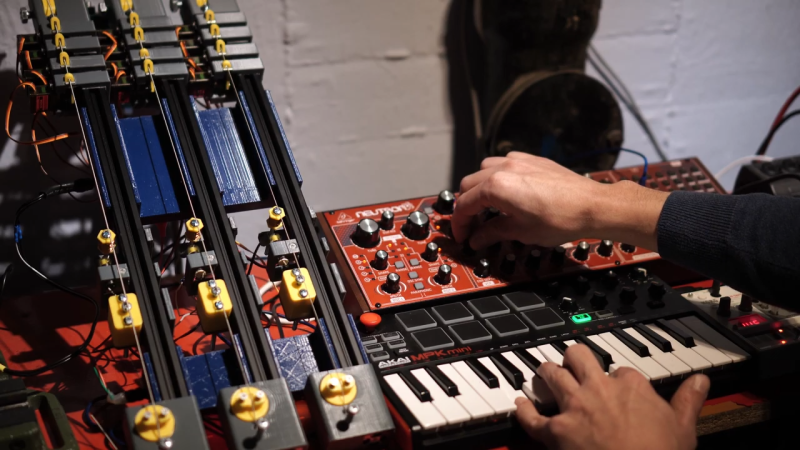Since the first of our ancestors discovered that banging a stick on a hollow log makes a jolly sound, we hominids have been finding new and unusual ways to make music. We haven’t come close to tapping out the potential for novel instruments, but then again it’s not every day that we come across a unique instrument and a new sound, as is the case with this string-plucking robot harp.
Named “Greg’s Harp” after builder [Frank Piesik]’s friend [Gregor], this three-stringed instrument almost defies classification. It’s sort of like a harp, but different, and sort of like an electric guitar, but not quite. Each steel string has three different ways to be played: what [Frank] calls “KickUps”, which are solenoids that strike the strings; an “eBow” coil stimulator; and a small motor with plastic plectra that pluck the strings. Each creates a unique sound at the fundamental frequency of the string, while servo-controlled hoops around each string serve as a robotic fretboard to change the notes. Sound is picked up by piezo transducers, and everything is controlled by a pair of Nanos and a Teensy, which takes care of MIDI duties.
Check out the video below and see if you find the sound both familiar and completely new. We’ve been featuring unique instruments builds forever, from not-quite-violins to self-playing kalimbas to the Theremincello, but we still find this one enchanting.
















Reminds me of a Pat Metheny Gig I attended a few years ago. It featured his “Orchestrion” project (a great number of simultaneously solenoid-played instruments).
https://youtu.be/KsYEOUKS4Yk
Orechestrions are *seriously neat*. If I had the space, time, and budget, I’d love to have one in my home.
Animusic incarnate (from the 90’s)…
https://youtu.be/hyCIpKAIFyo
…and Intel’s implementation of the above…
https://youtu.be/E4hjx3_A-cw?t=8
in terms of the instrument style in reminded me more of Acoustic Curves: https://youtu.be/zF26jtMA9U0
Not many frets but enough to chord on. But then I was expecting some slide action like the aforementioned ochestrion, with the self sustaining (e-bow) feature on. That’s more my style and mode.
I don’t understand the “defies classification” part. It’s very clearly an electric-string instrument, just like an electric guitar. All of the same properties seem to apply to it as well. That’s a big part of what makes electric guitars so much fun. It’s a string instrument that has a wide variety of well defined string lengths across multiple string sizes and multiple string compositions. It’s also an electromagnetic instrument thanks to the choice of strings that both are affected by electromagnetic effects and produce electromagnetic effects. In any case what you are doing it interacting with the strings to produce sounds, that’s the important part of how any string instrument works. The electromagnetic side of things opens up an entire second field of ways to interact with those strings, hence things like ebow being a thing that caught on.
To me this is little more than a really awesome extension for any other electric-string instrument (guitars aren’t the only ones in this class). Honestly I kind of want to put together an electric guitar with this thing worked into it’s design, hand off control of solonoids and such to a second person while I man the guitar. I imagine it would spawn a whole new electronic music genre.
Could get a double neck and put bass on the bottom with midi playing it or something.
Techie factor +1
Musical enjoyment factor … hmmmmm. At the beginning, the sound resembled a very fast ringing, muffled handbell being played in an echo-y hallway. Not my favorite way to jam.
Hammered dulcimers can been played in a way that generates a similar vibrato.
There was a guitar-playing robot at the World Expo in Brisbane in 1988. I think it was in the Japanese pavilion. It was a complex-looking beast, with six solenoids over each fret, a plucking and IIRC a strumming action. It sounded pretty good, but what fascinated me was the ability to pluck up to six strings at once – something a human player can’t do. A human can get pretty fast, and the technique of Mark Knopfler and others to play with a thumb and two fingers is fantastic to watch and liston to, but plucking six strings at once opens up some interesting possibilities. Also the ability to fret strings farther apart than the human hand can reach, and pluck those strings.
If you can pluck the same note on multiple strings, what does that do to the harmonics? I’m not a guitar player, would some expert care to chime in?
A skilled human can pluck 5 strings at once, which is probably close enough to what our ears can actually discriminate. This sort of technique is pervasive in classical guitar music, as is playing the same note on multiple strings.
The most famous example of playing the same note on different strings is probably Leyenda (Asturias) by Isaac Albeniz. If you listen you can here what sounds like a note being played twice, but let me assure you this is happening on different strings.
https://www.youtube.com/watch?v=_9u7TTxDGys
Great piece of music, btw.
I was waiting for the harpsichord to complete the composition. Brilliant instrument.
Whew! Im so out of touch!
Listen to arabic qanun…
I brake for positive weirdness! glad to see/hear this online. Hear my very different but (I think) kindred roster @ Collateral Timbre / Tools Of Engagement https://www.youtube.com/channel/UC-fDnSxhD9i5-B9zgWyuQKQ
KINDRED SOUL CONSTRUCTIVE WEIRDOSITY: COLLATERAL TIMBRE / Tools Of Engagement https://www.youtube.com/channel/UC-fDnSxhD9i5-B9zgWyuQKQ